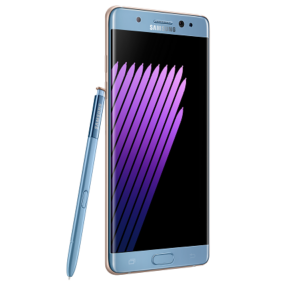Samsung changed its traditional September launch for its Note series last year to an earlier date, with encouraging results. The company has decided to stick with the same approach this year, announcing its new Galaxy Note 7 phablet in early August.
The waterproof capability of the Galaxy S7 was one of the most well-received features, and Samsung has taken that to heart. The Note 7 is IP68-compliant. It also features Samsung’s Knox security, the S Pen stylus and ‘HDR’ streaming (we asked Samsung about this and the claim simply means that the phone can show ‘HDR-like’ images – TA).
A 5.7″ always-on AMOLED display (2560 x 1440) is used on the Note 7, with two curved edges. This is the first time that a non-Edge (i.e. Galaxy S7 Edge) device has used this design, further differentiating Samsung’s product portfolio. The screen is protected by Corning’s Gorilla Glass 5.
A new Gear VR device was released at the same time, which can be used with the Note 7’s new USB-C port, as well as the micro-USB found on older Samsung phones. The new headset (SM-R323) has a 101° field of view, slightly up from the 96° in the preceding model, and is also lighter at 312g.
As well as the Gear VR, the Note 7 is compatible with Samsung’s Gear 360 camera, which was launched in the USA this month. It also features an iris scanner, in addition to a fingerprint scanner.
The dual-edge always-on display is not the only feature that Samsung has added to the Note from the S7 series. The new phone has the same camera technology (dual-pixel, wide aperture, fast autofocus) and shares some software, such as Samsung’s Game Pack.
Samsung has tweaked the S Pen stylus, adding new features like Screen Off Memo (a way to take notes without unlocking the phone); new Air Command (hover) features like Magnify and Translate; and a new app called Samsung Notes.
The Note 7 has 64GB of internal storage and a micro-SD slot (up to 256GB). The battery is a 3,500mAh device. A 64-bit octa-core processor, with 4GB of RAM, runs Android 6.0.1.
Analyst Comment
The inclusion of USB Type-C reinforces the suggestion that we reported earlier in the year that the lack of inclusion of the connector in the Galaxy S7 was just a matter of timing. Although the product lifetime of many mobile phones is relatively short, the development periods have to include substantial time for network operators to test them. Network operators are, understandably, very reluctant to ship millions of new handsets at launch time, if the product has not had exhaustive testing. (BR)

